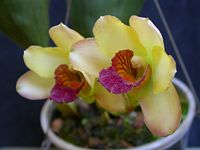Bifrenaria: Difference between revisions
imported>Dalton Holland Baptista (New page: {{subpages}}) |
imported>Dalton Holland Baptista No edit summary |
||
| Line 1: | Line 1: | ||
{{subpages}} | {{subpages}} | ||
{{taxobox | |||
| name = ''Bifrenaria'' | |||
| color =lightgreen | |||
| image =Bifrenaria harrisoniae.jpg | |||
| image_caption = ''Bifrenaria harrisoniae'' | |||
| domain = [[Eukaryota]] | |||
| regnum = [[Plantae]] | |||
| divisio = [[Magnoliophyta]] | |||
| classis = [[Liliopsida]] | |||
| ordo = [[Asparagales]] | |||
| familia = [[Orchidaceae]] | |||
| subfamilia = [[Epidendroideae]] | |||
| tribus = [[Cymbidieae]] | |||
| subtribus = [[Maxillariinae]] | |||
| genus = '''''Bifrenaria''''' | |||
| genus_authority = [[Lindl.]] 1832 | |||
| type_species ='''''Bifrenaria atropurpurea''''' | |||
| type_species_authority = [[Lindl.]] 1832 | |||
| subdivision_ranks = Species | |||
| subdivision = | |||
*20 species, see [[/Related_Articles|related articles]] | |||
| subdivision2_ranks = Synonyms | |||
| subdivision2 = | |||
*''Colax''<small> [[Lindl.]] ex [[Spreng.]] 1826</small> | |||
*''Adipe''<small> [[Raf.]] 1837</small> | |||
*''Stenocoryne''<small> [[Lindl.]] 1843</small> | |||
*''Cydoniorchis''<small> [[Senghas]] 1994</small> | |||
}} | |||
'''''Bifrenaria''''' is a genus of [[Orchids]] formed by twenty species of [[South America]], some among the favorites of orchid growers because of their abundant showy [[flower]]s, which are large and very fleshy and at first glance seem artificial flowers made of [[wax]]. There are no known uses for them other than ornamental. | |||
Despite the low number of species, they can be split in two clearly distinct groups:<ref name="Cogn"><span style="font-variant:small-caps;">Cogniaux, Celestin A.</span>(1902). ''Bifrenaria'' in Flora Brasiliensis K.F.P.von Martius & auct. suc. (eds.) vol.3 p. 5: 476. [http://florabrasiliensis.cria.org.br/search?taxon_id=237 published on Internet.]</ref> one of highly robust plants with large flowers, that encompass the first species to be classified under the genus ''Bifrenaria''; other of more delicate plants with smaller flowers occasionally denominated ''Stenocoryne'' or ''Adipe''. There are yet two other species that normally are classified as ''Bifrenaria'' but which molecular analysis indicate to belong to different orchid groups. They are ''Bifrenaria grandis'', endemic of [[Bolívia]], which many [[taxonomist]]s denominate ''[[Lacaena|Lacaena grandis]]'',<ref><span style="font-variant:small-caps;">Kraenzlin, Friedrich Wilhelm Ludwig</span> (1928). ''Lacaena grandis'' in Repertorium specierum novarum regni vegetabilis. Ed. Selbstverlag des Herausgebers, Berlin, at vol.25: 25.</ref> and ''[[Bifrenaria steyermarkii]]'', inhabitant of northern [[Amazon Forest]],<ref><span style="font-variant:small-caps;">Dunsterville, Galfried Clement Keyworth & Garay, Leslie A.</span> (1976). ''Bifrenaria steyermarkii'' in Venezuelan Orchids Illustrated vol.6: 56. London.</ref> which does not have an alternative classification as yet. | |||
==References== | |||
{{reflist|2}} | |||
Revision as of 12:42, 19 March 2009
| Bifrenaria | ||||||||||||||||||||
|---|---|---|---|---|---|---|---|---|---|---|---|---|---|---|---|---|---|---|---|---|
 Bifrenaria harrisoniae
| ||||||||||||||||||||
| Scientific classification | ||||||||||||||||||||
| ||||||||||||||||||||
| Type species | ||||||||||||||||||||
| Bifrenaria atropurpurea Lindl. 1832 | ||||||||||||||||||||
| Species | ||||||||||||||||||||
| ||||||||||||||||||||
| Synonyms | ||||||||||||||||||||
Bifrenaria is a genus of Orchids formed by twenty species of South America, some among the favorites of orchid growers because of their abundant showy flowers, which are large and very fleshy and at first glance seem artificial flowers made of wax. There are no known uses for them other than ornamental.
Despite the low number of species, they can be split in two clearly distinct groups:[1] one of highly robust plants with large flowers, that encompass the first species to be classified under the genus Bifrenaria; other of more delicate plants with smaller flowers occasionally denominated Stenocoryne or Adipe. There are yet two other species that normally are classified as Bifrenaria but which molecular analysis indicate to belong to different orchid groups. They are Bifrenaria grandis, endemic of Bolívia, which many taxonomists denominate Lacaena grandis,[2] and Bifrenaria steyermarkii, inhabitant of northern Amazon Forest,[3] which does not have an alternative classification as yet.
References
- ↑ Cogniaux, Celestin A.(1902). Bifrenaria in Flora Brasiliensis K.F.P.von Martius & auct. suc. (eds.) vol.3 p. 5: 476. published on Internet.
- ↑ Kraenzlin, Friedrich Wilhelm Ludwig (1928). Lacaena grandis in Repertorium specierum novarum regni vegetabilis. Ed. Selbstverlag des Herausgebers, Berlin, at vol.25: 25.
- ↑ Dunsterville, Galfried Clement Keyworth & Garay, Leslie A. (1976). Bifrenaria steyermarkii in Venezuelan Orchids Illustrated vol.6: 56. London.